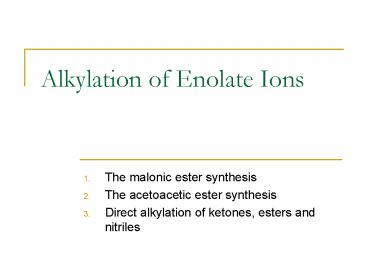Alkylation of Enolate Ions PowerPoint PPT Presentation
Title: Alkylation of Enolate Ions
1
Alkylation of Enolate Ions
- The malonic ester synthesis
- The acetoacetic ester synthesis
- Direct alkylation of ketones, esters and nitriles
2
Relative acidity of selected organics
- Structure pKa
- 5
- 9
- 11
- 13
- These compounds are MORE ACIDIC than CH3CH2OH
(pKa 16) NaOCH2CH3 can
deprotonate them.
3
Relative acidity of selected organics
- Structure pKa
- 16
- 17
- 19
- These compounds are SLIGHTLY LESS ACIDIC than
CH3CH2OH - NaOCH2CH3 would result in only a small amount
of deprotonation.
4
Relative acidity of selected organics
- Structure pKa
- 25
- 25
- 35
- 40
- These compounds are MUCH LESS ACIDIC than
CH3CH2OH - to deprotonate the top two, a base such as the
R2N anion must be used.
5
Acidity of b-dicarbonyl compounds
A base removes a proton a to both carbonyl groups
Resonance stabilizes the resulting anion
6
General mechanism for alkylation
The anion attacks the carbon bearing a leaving
group
A second equivalent of base can remove the second
proton
7
Introduction of a second alkyl group
This anion can be alkylated by a second alkyl
halide
8
Hydrolysis and Decarboxylation
a substituted malonic ester
a substituted acetic acid
9
Hydrolysis and Decarboxylation
a substituted acetoacetic ester
a substituted acetone
10
Overall Process, single substitution,
using abbreviations
11
Overall Process, double substitution,
using abbreviations
12
Forming a ring that includes the a-carbon
Substituted acetic acids having a ring that
includes the a-carbon can be synthesized
similarly using diethyl malonate
5- or 6-membered rings can be made using a 4- or
5-carbon alkyl dihalide
13
Direct alkylation of ketones, esters, and
nitriles (but NOT aldehydes)
PowerShow.com is a leading presentation sharing website. It has millions of presentations already uploaded and available with 1,000s more being uploaded by its users every day. Whatever your area of interest, here you’ll be able to find and view presentations you’ll love and possibly download. And, best of all, it is completely free and easy to use.
You might even have a presentation you’d like to share with others. If so, just upload it to PowerShow.com. We’ll convert it to an HTML5 slideshow that includes all the media types you’ve already added: audio, video, music, pictures, animations and transition effects. Then you can share it with your target audience as well as PowerShow.com’s millions of monthly visitors. And, again, it’s all free.
About the Developers
PowerShow.com is brought to you by CrystalGraphics, the award-winning developer and market-leading publisher of rich-media enhancement products for presentations. Our product offerings include millions of PowerPoint templates, diagrams, animated 3D characters and more.

